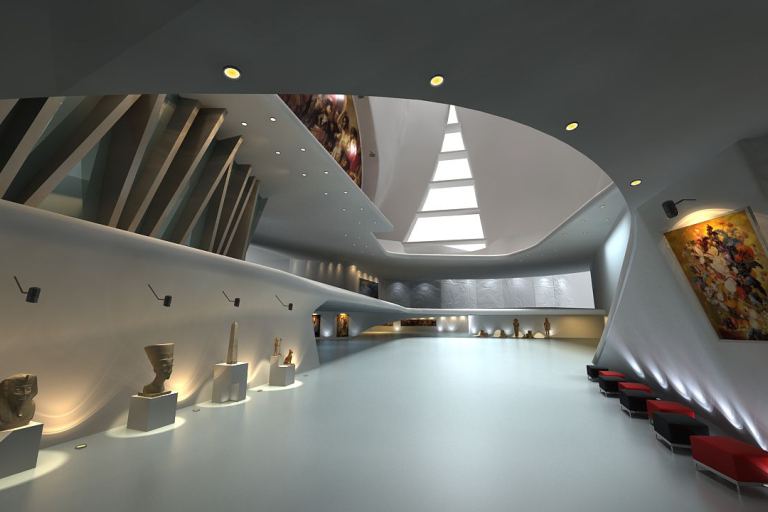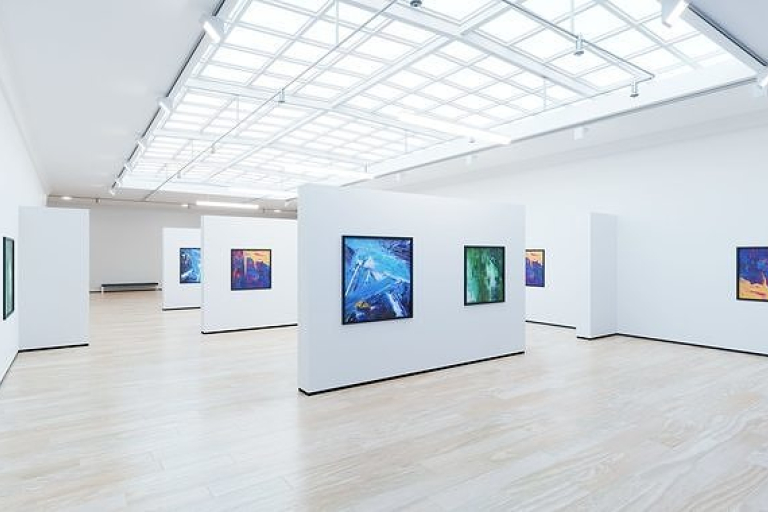As the world progresses into an era of digital transformation, museums are poised to embrace unprecedented opportunities for innovation and accessibility. Here at Harmony AT, we're at the forefront of this revolution, using a groundbreaking approach that merges museum 3D model with Building Information Modeling (BIM) to reimagine the museum experience entirely. This blog post dives into this transformative potential. We'll explore how 3D modeling and BIM are reshaping the landscape of museum design, curation, and visitor engagement, paving the way for a future where cultural exploration thrives.
Understanding Museum 3D Models: A Gateway to Innovation
Museum 3D models are digital representations of artifacts, architectural structures, and exhibition spaces created using three-dimensional modeling techniques. These models capture intricate details, textures, and spatial relationships with remarkable accuracy, providing immersive experiences for researchers, educators, and visitors alike. Beyond mere replicas, museum 3D models serve as invaluable tools for documentation, conservation, and virtual exhibition, offering new perspectives on cultural artifacts and historical contexts.

Exploring BIM Museum 3D Modeling Services from Harmony AT
Harmony AT's BIM museum 3D modeling services offer a revolutionary approach to managing museums. This comprehensive suite transcends static models, creating a dynamic digital twin of the museum itself. Let's explore the five key components that empower this transformation:
Architectural BIM Museum 3D Modeling
Harmony AT goes beyond simple 3D models. Our architectural BIM models capture intricate details like vaulted ceilings, decorative moldings, and unique design elements. This digital replica becomes an invaluable asset. Museums can utilize it for preservation planning, identifying potential structural issues before they become major problems. Additionally, it facilitates accessibility assessments, ensuring the museum is welcoming to all visitors. Perhaps most importantly, architectural BIM models allow for meticulous visualization and planning of future renovations or expansions, minimizing disruption to existing exhibits.

Structural BIM Museum 3D Modeling
We delve deeper than aesthetics with structural BIM museum modeling. This service analyzes the museum's very foundation, providing crucial insights into its structural integrity. A key component of this analysis is load-bearing capacity assessment. Identifying potential weak points allows museums to address structural concerns proactively, ensuring the safety of both staff and priceless collections. Structural BIM models also offer valuable insights into the building's overall health and stability, empowering informed maintenance and preservation planning for the long term.
MEP BIM Museum 3D Modeling
BIM extends beyond the physical structure. Harmony AT offers MEP modeling, integrating data on the museum's Mechanical, Electrical, and Plumbing systems into the BIM model. This empowers museums to optimize building operations. We can identify areas for system upgrades, manage energy consumption more efficiently, and plan proactive preventative maintenance to ensure the longevity of these critical systems. Most importantly, MEP BIM modeling helps maintain optimal temperature, humidity, and air quality – essential factors for preserving artifacts within the museum's walls.
Scan to BIM Transformation
Harmony AT leverages cutting-edge laser scanning technology to capture a "point cloud" - a dense collection of data points representing the museum's entire physical space in meticulous detail. However, raw scan data isn't readily usable. Here's where Harmony AT's expertise comes in. We transform this point cloud data into a rich BIM model. This process translates the raw data into a comprehensive museum 3D model, incorporating details from architectural and structural BIM modeling, along with critical spatial relationships between these components.
Museum 3D Model Rendering and Visualization
Harmony AT doesn't stop at technical data. Our team creates stunning museum 3D model renderings and visualizations, bringing the museum to life both inside and out. These visuals have a multitude of applications. They can be used to offer virtual tours, expand audience reach and foster global engagement. Additionally, these renderings empower the development of captivating interactive exhibits that allow visitors to explore exhibits in detail and delve deeper into the museum's stories. Finally, they can be used for accessibility planning, visualizing potential challenges, and creating solutions for a more inclusive visitor experience.
Read more: Bring Your Stadium Vision to Life: The Power of Stadium 3D Model
Challenges in Building, Preserving, or Renovating Museums
Museums are sanctuaries for our cultural heritage, but maintaining these institutions comes with a unique set of challenges. Here's a closer look at the hurdle’s museums face in building, preserving, or repairing their structures and collections:
Building Challenges
Balancing Historical Integrity with Modern Needs
Museums often reside in historic buildings that require careful restoration while incorporating modern amenities like climate control and accessibility features. This delicate balance can be expensive and technically complex.
Creating Functional and Flexible Spaces
Museum exhibits constantly evolve, requiring spaces that can adapt to new displays and technological advancements. Designing flexible layouts and infrastructure can be a challenge, especially in older structures.
Sustainable Design and Energy Efficiency
Museums have high energy demands due to climate control for artifact preservation. Balancing these needs with sustainable design practices and energy efficiency goals requires innovative solutions.
Preservation Challenges
Environmental Control
Maintaining consistent temperature, humidity, and light levels is crucial for preventing damage to artifacts. This can be expensive, especially in large buildings with varying climates.
Conservation and Restoration
Museums house a vast array of artifacts with diverse material needs. Ensuring proper conservation techniques and access to skilled professionals can be a significant challenge.
Disaster Preparedness and Risk Management
Museums are vulnerable to natural disasters, fires, and other unforeseen events. Developing robust disaster plans, mitigation strategies, and ensuring proper insurance coverage is essential.
Renovation Challenges
Balancing Repairs with Ongoing Operations
Museum closures for repairs can significantly impact revenue and visitor experience. Minimizing disruptions and finding creative solutions for maintaining access to exhibits during repairs is crucial.
Sourcing Replacement Materials
Historic buildings often use materials no longer readily available. Finding suitable replacements for repairs requires careful research and sourcing strategies.
Harmony AT's BIM Museum 3D Model Services: Transforming Challenges into Triumphs
Museums, stewards of our cultural heritage, face unique challenges when building, preserving, or renovating their spaces. Harmony AT's BIM museum 3D modeling services offer a powerful solution, turning these obstacles into opportunities for success. Let's explore the benefits of BIM for each of these critical areas:
Effortless Integration
Harmony AT's BIM museum 3D model captures both historic details and modern needs. This allows for seamless integration of essential upgrades like climate control systems and accessibility features, ensuring a harmonious blend of the past and present without compromising the museum's character.
Adaptability for the Future
BIM museum 3D model offers flexible layouts that can be easily modified to accommodate new exhibits and technological advancements. This ensures the museum remains engaging and relevant for future generations of visitors.
Sustainable Practices Made Easy
High energy demands for artifact preservation are a common concern. Through MEP BIM modeling, we help identify areas for energy-efficient upgrades within the building systems. This promotes sustainable practices without compromising vital environmental controls for artifact safety.
Proactive Environmental Control
Maintaining consistent temperature, humidity, and light levels is crucial for preventing artifact damage. Harmony AT's BIM models allow for virtual analysis of these factors. This empowers museums to identify potential environmental risks and develop proactive strategies for optimal climate control, ensuring the long-term well-being of their collections.
Informed Conservation Decisions
Each artifact has unique preservation needs. BIM models can integrate relevant conservation data, making this information readily accessible to curators and conservators. This empowers informed decision-making, ensuring proper care for each precious object.
Disaster Preparedness
Natural disasters and fires pose significant threats. BIM models from Harmony AT serve as a valuable tool for developing comprehensive disaster plans. Virtual walkthroughs allow for planning evacuation routes and identifying vulnerable areas, minimizing potential damage and ensuring the safety of both staff and collections.
Precise Planning, Efficient Execution
Repairs on historic buildings often require specialized skills. Harmony AT's detailed architectural and structural data within the BIM models provides a valuable resource for contractors. This allows for precise planning, minimizing the need for on-site adjustments and reducing reliance on scarce skilled labor, leading to more efficient renovations.
Minimized Disruption, Maximized Experience
Museum closures are disruptive to visitors and revenue. BIM models allow for virtual walkthroughs of planned renovations. This helps identify potential clashes between existing and new elements beforehand, minimizing construction disruptions and ensuring a smooth transition to the renovated space.
Preserving the Past, Embracing the Future
Sourcing historic materials can be challenging. Harmony AT's detailed BIM models offer meticulous analysis of existing materials. This empowers informed decisions regarding sourcing replacements or developing innovative solutions for repairs, ensuring the museum's historic fabric is preserved for future generations.
By partnering with Harmony AT and leveraging BIM museum 3D modeling services, museums can transform challenges into triumphs. This technology empowers them to build, preserve, and renovate their spaces with greater efficiency and foresight, ensuring the continued protection and celebration of our irreplaceable cultural heritage for years to come.
Categories





